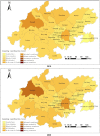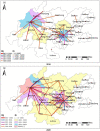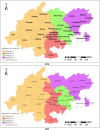Research on the spatiotemporal characteristics and influence mechanism of the integration of the health industry and tourism industry in the Chengdu-Chongqing economic circle of China
- PMID: 37780454
- PMCID: PMC10534956
- DOI: 10.3389/fpubh.2023.1234259
Research on the spatiotemporal characteristics and influence mechanism of the integration of the health industry and tourism industry in the Chengdu-Chongqing economic circle of China
Abstract
Introduction: Given the background of the "Healthy China" strategy and the aging population, the high-quality integration of the health industry and tourism industry is of great significance to meet the national health tourism needs and promote regional coordinated development.
Methods: Taking the Chengdu-Chongqing economic circle as an example, this paper uses the coupling coordination degree method and geographic detectors to explore the spatiotemporal characteristics and influence mechanism of the integration of the health industry and tourism industry in the Chengdu-Chongqing region.
Results: (1) The integration level of the Chengdu-Chongqing economic circle as a whole, four major regional sectors, and 36 cities is relatively low, and the regional differences in the degree of coupling coordination are relatively large, showing a three-level change. Overall, the spatial differentiation characteristics are high in the west and low in the east, radiating from the two nuclei to the periphery. (2) There are obvious regional differences in the spatial connection strength of the integration of the two major industries, which form a radial non-equilibrium structure with the Chengdu and Chongqing main cities as the connection centers. The overall spatial connection network structure is relatively loose, the point-degree centrality has the spatial distribution characteristics of dominated by two poles, led by multiple cores, and weak at the edges, and the division of cohesive subgroups is greatly affected by geographical factors and administrative divisions. (3) The temporal and spatial characteristics of the integration of the two industries are the result of the mutual coupling of market demand, industrial development, policy support, and economic development.
Discussion: The high-quality integrated development of the health industry and the tourism industry is a complex systematic project, which requires the assistance of government departments at all levels and health tourism enterprises in the Chengdu-Chongqing economic circle to strengthen coordination and cooperation.
Keywords: Chengdu-Chongqing economic circle; driving factor; health tourism; influence mechanism; spatiotemporal characteristics.
Copyright © 2023 Chen and Deng.
Conflict of interest statement
The authors declare that the research was conducted in the absence of any commercial or financial relationships that could be construed as a potential conflict of interest.
Figures





Similar articles
-
Evaluating the corresponding relationship between the characteristics of resource utilization and the level of urbanization: a case study in Chengdu-Chongqing Economic Circle, China.Environ Sci Pollut Res Int. 2022 Aug;29(37):55816-55829. doi: 10.1007/s11356-022-19630-z. Epub 2022 Mar 23. Environ Sci Pollut Res Int. 2022. PMID: 35322364
-
[Spatio-temporal Evolution and Coordinated Development of Compactness with Carbon Emission Intensity in the Chengdu-Chongqing Urban Agglomeration].Huan Jing Ke Xue. 2024 Jun 8;45(6):3402-3411. doi: 10.13227/j.hjkx.202307260. Huan Jing Ke Xue. 2024. PMID: 38897761 Chinese.
-
Examining the spatial networks of an urban agglomeration through the lens of multi-dimensional element flow: Evidence from western China.Heliyon. 2023 Oct 13;9(10):e20949. doi: 10.1016/j.heliyon.2023.e20949. eCollection 2023 Oct. Heliyon. 2023. PMID: 37876482 Free PMC article.
-
Equity and efficiency of health resource allocation in the Chengdu-Chongqing Economic Circle of China.Front Public Health. 2024 Aug 27;12:1369568. doi: 10.3389/fpubh.2024.1369568. eCollection 2024. Front Public Health. 2024. PMID: 39257950 Free PMC article.
-
Can the integration of sports and health industries drive the upgrade of the sports industry?-An empirical study based on Chinese-style modernization.PLoS One. 2024 Feb 7;19(2):e0297974. doi: 10.1371/journal.pone.0297974. eCollection 2024. PLoS One. 2024. PMID: 38324531 Free PMC article. Review.
Cited by
-
Geospatial analysis of sports tourism resources in China's urban clusters: a case study of the Sichuan-Chongqing region utilizing GIS and the geographic detector.Front Sports Act Living. 2024 Dec 9;6:1496469. doi: 10.3389/fspor.2024.1496469. eCollection 2024. Front Sports Act Living. 2024. PMID: 39717492 Free PMC article.
References
-
- Wenjing D, Changsen W, Zhen Z. The spatiotemporal evolution and spatial correlation pattern of the coupled development of China's cultural industry and tourism industry. J Southwest Univ Nat. (2022) 43:23–33. doi: 10.3969/j.issn.1004-3926.2022.03.004 - DOI
-
- Nana G, Xiuying S. Research on the coupling coordination of ecological environment-tourism industry-urbanization in the Yellow River Basin. Eco Issues. (2022) 3:13–9. doi: 10.16011/j.cnki.jjwt.2022.03.003 - DOI
-
- Xiang H, Hongqiao F. Demonstration of the coordinated development of tourism industry and provincial economy: taking Hainan Province as an example. Stat Decision-Making. (2022) 38:79–82. doi: 10.13546/j.cnki.tjyjc.2022.12.015 - DOI
-
- Baibi C, Weiping H. Coupling evaluation and development strategies of rural tourism and precision poverty alleviation: taking Nanping City as an example. J Fujian Normal Univ. (2021) 5:82–89+169. doi: 10.12046/j.issn.1000-5285.2021.05.008 - DOI
-
- Ping G, Xuefen H, Chao L. Research on the coupling development of Jiuhua Mountain health tourism industry. Manag Observ. (2018) 23:3.
Publication types
MeSH terms
LinkOut - more resources
Full Text Sources

